|
Features,
Honors
& Awards, Ag
Announcements
Ag News Elsewhere
(fresh daily from the Web)
|
|
Features
|
|
Of
dogs and the spirit of competition
A
dogís eye view of Saturday's 4-H Dog Show
[JULY
30, 2001] The
dogs were ready at 8, when the show was supposed to begin, but the
owners were not so relaxed. Each trainer glanced nervously from one
side to the other, checking out the opposition, sizing them up.
These trainers, all of them young children with exceptionally
trained dogs, had come from across the county, every one of them
hoping to take home a trophy for proud display on their fireplace
mantels. They sulked across the dirt space in front of the arena
where the judging would take place, watching, praying that their
dogs might perform a cut above the rest.
|
|
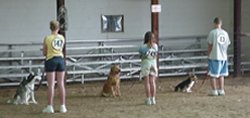
Without
any warning, the show began with the silent entry of the lone Dog
Care class contestant. This magnificent animal stood there,
completely docile, while the judge meticulously checked that the dog
had been well cared for: a clean, unmatted coat, trimmed nails,
clean ears and clear eyes. When the examination was finished, he
announced only two things that led to points being deducted: a few
fly bites on the ears and a bit of tartar growth on the teeth. Other
than that, the creature seemed to be exceptionally well taken care
of, and the grinning boy was given his award to much applause.
Fifteen
minutes had passed since the show began, and the masses had become
restless. The crowd was hungry for real meat. Without a doubt, it
was time for the Obedience class to show what they could do.
The
14 dogs, followed by their respective trainers, filed into the
arena, where they were given lengthy instructions on what they were
to do when it their turn arrived. From what I could hear, the
instructions had a faintly militant tone to them: sit, stand, heel,
about face, slow, run, walk. The trainers understood what they were
told, but the dogs were clearly not so easy to reach ó maybe it
was the heat. The dogs bore the same expression in their eyes, as if
questioning the reasons for their presence there: OK,
you want me to do what? Sit, walk forward, heel, turn left, walk,
then run, then turn around, and walk back? Got it. I can play the
bagpipes as well. Would you like me to play the bagpipes for you?
Maybe I can prepare you a spot of tea while Iím at it?

Of
course, the dogsí mocking glances toward the judge were nothing
compared to their harsh comments towards their trainers: Ouch,
stop pulling on my chain, boss! Keep that up, and I might just sit
down and never get up again! Oh, you want to test me? Iím sitting
down, Iím going to do it, and I mean it this time, I will! Come
on, all I want is some attention! Do I really need to act like this
in order for you to love me?
[to top of second column in
this article]
|
To
those watching the dogs perform, it was evident that they all did
want to please their masters. They would plod along merrily, heeling
and sitting when instructed. Occasionally, when they were to walk
around two men in a figure eight, they would start sniffing at the
dog hair smell on one of the men chosen to play the posts.
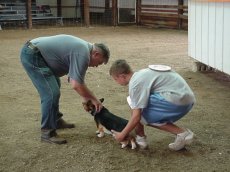
Clay
Glover, show supervisor and trainer, told me that with the way some
of the dogs had behaved during the first days of training ó some
hyper to the point of needing Valium ó their performance at the
show was amazing. I had to agree, even though I had not seen them
during their training. While some of the dogs seemed a trifle
high-strung at times, all of them very clearly belonged at the show.
Four
hours and 14 individual performances later, the contestants were
divided into two groups of seven. Each group was to perform a long
sit, for one minute, and a long lay, for three minutes. Some of the
dogs had no problem with these exercises: OK, Iíll stay. Hey,
this is actually pretty decent! No parading around, getting hot and
tired. Just sit here and wait. No problem. Others, however, were
less eager and promptly disobeyed their mastersí commands:
Donít leave me! Iím sorry about not sitting still earlier! Iíll
be a good doggie, but please donít leave me! That dog over there
is giving me dirty looks! Help!
After
all was said and done, nearly five hours after the start of the
show, the dogs came into the arena one last time, as a group, each
of them on equal footing, knowing that they had done their best. Only
one winner is chosen from each of four classes. For each, as they
heard their number called, trainer and dog proudly stepped forward,
the camera flashed, and they were the winners in the Logan County
2001 4-H Dog Show this Saturday, Aug. 28.
[Jonathan
Cook]
[Click
here to see results of the 4-H Dog Show]
|
|
|
Logan
County crops ó a varied picture
[JULY
26, 2001] Logan
County has become a varied picture in agriculture over the past few
weeks. With critical timing from the first week of July to date for
corn, much-needed rainfall fell in some areas. Other areas were
virtually shut out. Pictured below is an ear of corn with poor
pollination due to heat stress at a critical time.
|
|
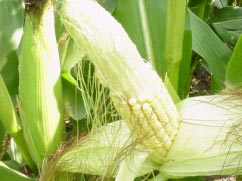
Also
noticeable in area cornfields was the firing of lower leaves due to
the heat and moisture stress, as plants protected themselves and
continued filling kernels on the ear.
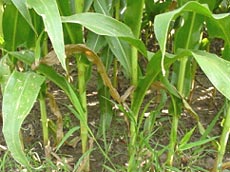

Insect
damage was also seen, with rootworm beetles causing some silk
clipping and corn borers riddling some stalks.
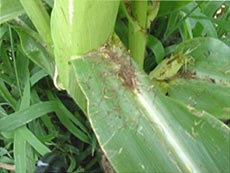
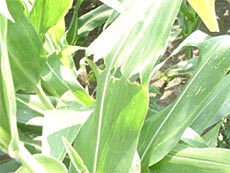

Soybeans
have a critical point approaching as they start the pod-fill period.
They continue to bloom, set pods and begin to make the seeds grow.

[to top of second column in
this article]
|
Many
insects, such as bean leaf beetles and grasshoppers, have caused
some minor defoliation in the soybean leaves.

For
the horticulturalist in us, we have seen the wilt virus transmitted
by beetles in the cucurbits, such as pumpkins and cucumbers.

And
lastly we have a problem we can take care of. That is damage by
potato leafhoppers. It is indicated by a brown or black
"V" at the tip of leaves. A simple spray treatment of
diazinon or carbaryl will prevent further damage. This picture
happens to be a rose.
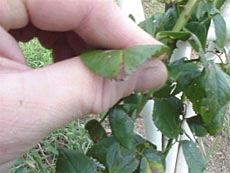
Not
all is bad, but it does make for some more dramatic pictures. If
weather could be custom-ordered, it would involve about an inch of
rain a week (and more than a tenth or two at a time would be nice),
high temperatures of about 85 degrees and lots of sun.

The
next items coming to Lincoln Daily News from the Extension
office will be fair photos. The Logan County Fair will officially
open on July 31 and will run through Aug. 5. The 4-H shows have
already begun, with foods and clothing exhibited before the fair.
Dogs will show on the Saturday before the fair, and most project
divisions will be shown on the Monday before the fair. Hope to see
you there!
[John
Fulton]
|
|

|
|
|
New
techniques keep streams
from carrying away farmland
[JULY
24, 2001] "Ninety-three
percent of Logan County is farmland, and 97 percent of that farmland
is prime land ó
thatís as good as you get," says Bill
Dickerson. Preserving that prime black soil is a high priority for a
group of local and national organizations.
[Click
here for more photos]
|
|
A
field day sponsored recently by the Logan County Soil and Water
Conservation District and the Land of Lincoln Soil Savers gave area
farmers a look at a new stream stabilization technique, one way to
control soil erosion. These two groups, along with the U.S.
Department of Agriculture Natural Resources Conservation Service and
the Illinois Department of Agriculture are working on projects to
prevent Logan Countyís waterways from carrying away its farmland.
"With
three good-sized creeks in the county ó
Salt, Kickapoo and Sugar Creeks ó
itís a never-ending job," Dickerson says. As
a district conservationist for the NRCS, Dickerson works closely
with Logan Countyís Soil and Water Conservation District.
On
Thursday he took a group of area farmers to a Kickapoo Creek site
southeast of Atlanta, on farm ground owned by Dave Evans and Dan
Koons, to explain a new technique called the stream barb system.

[These
three rock projections are a new stream stabilization technique
called barbs. Pointing
upstream, they work together to redirect the water in Kickapoo Creek
toward the middle of the creek and keep it from undercutting the
stream bank.]
What
the farmers saw were three projections of large stone riprap jutting
out into the creek, angling upstream, at a point where the creek had
been cutting away the bank. The barb-shaped stone projections work
together to catch the current and redirect it to the middle of the
stream, away from the bank which is being eroded.
The
project was completed in December of last year, and, according to
the landowners, is working just as predicted.
"A
few weeks ago, when the water was higher, I could see it working. I
could actually see water turn and go back into the channel,"
Koons said.
Before
the barbs were put in, he added, the bank went straight down,
because it was being undercut by the creek at the rate of at least a
foot a year. Now the stream bank slopes, maintaining the angle it
was given by the construction crew that put in the new stabilization
system. The bank is also being held in place by the natural
vegetation that is beginning to grow there.
The
new stream barb system is protecting about 600 feet of the bank of
Kickapoo Creek, Dickerson says, preventing the loss of about
one-half ton of soil per foot per year. That means 300 tons of prime
topsoil is no longer washing down the creek, eventually ending up
somewhere in the Gulf of Mexico.

It is
the nature of streams and rivers to meander, traveling in a series
of S-curves, as they slow down and broaden out their flood plains,
Dickerson explains. Formerly, engineers tried to keep streams from
eroding the land around them by straightening them out, a process
called channelizing. Kickapoo Creek was channelized on the Koons-Evans
farm in the mid-1970s, when the land belonged to a different owner.
But
the channelizing couldnít prevent the creek from reverting to its
natural tendency to meander, and it soon began cutting into the land
again. (Itís now against federal law to straighten a stream.)
Today
the idea is to work with nature, allowing the stream to meander but
preventing it from meandering too much, Dickerson explains.
"Moving water is one of the strongest forces on earth. We are
now going with the natural force of the stream, rather than fighting
it."
[to top of second column in
this article]
|

Although
itís the newest technique, the stream barb system on the Koons-Evans
farm isnít the only system on Kickapoo Creek that is keeping Logan
County soil in Logan County. Two different projects upstream, called
bendway weirs and similar to the barb system, are on land owned by
Rodney Alberts and Jerry Cisco. They were also installed with the
help of Dickerson and the Soil and Water Conservation District.
These
stream stabilization systems not only save soil, they also
contribute to better water quality. They prevent streams from
filling up with sediment and also prevent agricultural chemicals and
nutrients from draining into waterways. Dickerson says the weirs and
barbs are also good for wildlife. A degrading stream is sterile,
providing little or no natural habitat. Rock bars, however, make
good aquatic habitats, places for fish to hide or breed.
Dickerson
explained the process of constructing the stream barb system to the
group of about 30 farmers who came to the site, pointing out that
the average cost of installing such a system on a Logan County farm
would be about $11,000. However, the Illinois Department of
Agriculture has a $1 million program in place this fiscal year (July
1, 2001 to June 30, 2002) to help fund stream stabilization, and
farmers who put in an approved system can get as much as 75 percent
of the cost reimbursed.

Several
construction firms in the area do the work, Dickerson said, and the
NRCS is ready to help farmers do the paperwork. A steam
stabilization project usually takes about a year from start to
finish because of the permits required -- from the U.S. Army Corps
of Engineers, the Illinois Environmental Protection Agency and the
Illinois Department of Natural Resources.
The
NRCS has been doing stream stabilization projects for the past 10
years, along with a number of other conservation programs. These
include no-till farming, which according to Dickerson has
contributed more to soil erosion control than any other program, and
the Conservation Reserve Program, the USDAís most popular
conservation program. CRP allows landowners to take cropland out of
production for as much as 15 years, getting payments of as high as
$192 an acre for the idle land. The land can be put in grass for
erosion control or planted with trees. Most land in CRP is already
environmentally sensitive, Dickerson says, often located on a flood
plain or on sloping ground.
After
viewing the stream barb system, the farmers adjourned to the Atlanta
Park shelter, where they heard a program by Howard Brown, agronomist
with Growmark of Bloomington. Brown walks the fields, looks at crops
for indications of insects, fungus and other plant diseases, and
gives farmers an update on how the season is progressing and what to
look for when making decisions for next yearís planting.
Brown
said the yield potential for area crops this year looks good
"if the weather is good from here on out."
Anyone interested in more
information about stream stabilization or other conservation
practices may call the Soil and Water Conservation District office
at (217) 732-2010, Ext. 3.
[Joan
Crabb]

|
|

|
|
|
Food,
fashions and more
4-Híers
participate in local showings
[JULY
20, 2001] The
Logan County 4-H Food and Nutrition Show was on Tuesday, July 17, at
the Extension Building on the fairgrounds. Approximately 70 youth
participated in the event. The Logan County 4-H Home and
Family Show was the same day. Approximately 35 youth participated in
that event. Illinois State
Fair delegates and alternates were chosen in several categories.
|
|
Foods
Delegates
Chris
Ackerman, Lincoln; Food Preservation
Emily
Bakken, Lincoln; Dairy Foods, Breads and Cereals, and International
Foods
Elizabeth
Carter, Lincoln; Food Preservation
Abby
Coers, Chestnut; Fruits & Vegetables
Natalie
Coers, Emden; International Foods, and Breads and Cereals

[Foods delegates chosen to represent Logan County 4-H
at the Illinois State Fair are (back row, L to R) Elizabeth Carter,
Chris Ackerman, Jennifer Schahl, Krista Ubbenga, Angela Cunningham
and Natalie Coers; (front row, L to R) Jill Patrick, Jenna Opperman,
Kim Turner, Emily Bakken and Abby Sasse. Not pictured: Laura Schahl
and Abby Coers.]
Angela
Cunningham, Elkhart; Breads and Cereals
Jenna
Opperman, Lincoln; You Learn to Bake
Jill
Patrick, New Holland; Sports Nutrition, Food Demonstration
Abrigail
Sasse, Beason; Breads and Cereals, Fruits and Vegetables, and
International Foods
Jennifer
Schahl, Lincoln; International Foods
Laura
Schahl; Lincoln, Letís Start Cooking
Kim
Turner, Atlanta; International Foods
Krista
Ubbenga, Hartsburg; Breads and Cereals, Food Preservation, and
Fruits and Vegetables
Alternates
Benjamin
Buse, Beason; Exploring Food Heritage
Elizabeth
Carter, Lincoln; Exploring Food Heritage
Susan
Cochran, Mount Pulaski; Fruits and Vegetables
Jonathon
Davis, New Holland; Tricks for Treats I
Amanda
Davison, Beason; Dairy Foods
Holly
Ingram, Lincoln; Fruits and Vegetables
Allicent
Pech, Lincoln; Sports Nutrition

[Foods
category alternates chosen are (L to R) Holly Ingram, Allicent Pech,
Elizabeth Carter, Amanda Davison and Susan Cochran.
Not pictured: Jonathon
Davis and Benjamin Buse.]
Top
Foods 4-Híers in Logan County
The
following 4-Híers were chosen as top individuals in Foods. These
4-Híers will compete for an overall county award which will be
presented at the 4-H Achievement Night in November.
Chris
Ackerman, Lincoln; Food Preservation
Emily
Bakken, Lincoln; Dairy Foods, Breads and Cereals, and International
Foods
Elizabeth
Carter, Lincoln; Food Preservation
Abby
Coers, Chestnut; Fruits and Vegetables
Natalie
Coers, Emden; International Foods, and Breads and Cereals
Angela
Cunningham, Elkhart; Breads and Cereals
Jenna
Opperman, Lincoln; You Learn to Bake
Jill
Patrick, New Holland; Sports Nutrition, and Food Demonstration
Abrigail
Sasse, Beason; Breads and Cereals, Fruits and Vegetables, and
International Foods
Jennifer
Schahl, Lincoln; International Foods
Laura
Schahl, Lincoln; Letís Start Cooking
Kim
Turner, Atlanta; International Foods
Krista
Ubbenga, Hartsburg; Breads and Cereals, Food Preservation, and
Fruits and Vegetables
Click
here for complete results of the 4-H Food and Nutrition Show.
[to top of second column in
this article]
|
Home
and Family Show
At
the Home and Family Show, a number of 4-Híers were chosen as award
winners and to go on to the Illinois State Fair. These individuals
are listed below.
Bethany
Furman, Waynesville ó Sewing and Textiles I Construction Award
Allicent
Pech, Lincoln ó Sewing and Textiles II Construction Award
Krista
Ubbenga, Hartsburg ó Sewing and Textiles III Construction Award
Leila
Ballinger, Atlanta ó 4-H Fashion Revue Award
Nichole
Benz, Lincoln ó Special Sewing and Textiles Award
Colleen
Pech, Lincoln ó Special Sewing and Textiles Award
Sewing and Textiles
Delegates
Leila
Ballinger, Sewing and Textiles III
Bethany
Furman, Sewing and Textiles I
Leanna
Gleason, Sewing and Textiles II
Allicent
Pech, Sewing and Textiles II
Abrigail
Sasse, Sewing and Textiles III
Krista
Ubbenga, Sewing and Textiles III
Marjorie
White, Sewing and Textiles II

[Clothing and Textiles delegates are (L to R)
Allicent Pech, Leila Ballinger, Bethany Furman, Krista Ubbenga,
Marjorie White, Abby Sasse and Leanna Gleason.]
Alternates
Emily
Bakken, Sewing and Textiles III
Katelyn
Beavers, Sewing and Textiles II
Abby
Coers, Sewing and Textiles II
Amanda
Davison, Sewing and Textiles III
Rachael
Jones, Sewing and Textiles I
Kim
Turner, Sewing and Textiles II
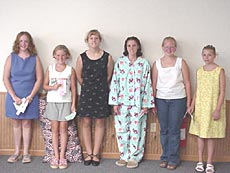
[Clothing and Textiles alternates are (L to R) Amanda
Davison, Rachael Jones, Katelyn Beavers, Emily Bakken, Kim Turner
and Abby Coers.]
Fashion Revue
Delegates
Emily
Bakken, Lincoln
Leila
Ballinger, Atlanta
Katelyn
Beavers, Broadwell
Krista
Ubbenga, Hartsburg
Alternates
Leanna
Gleason, Elkhart
Allicent
Pech, Lincoln
Marjorie
White, Beason
Interior Design
Delegates
Bethany
Furman, Waynesville; Beginning
Sarah
Moore, Elkhart, Beginning
Jenna
Opperman, Lincoln; Beginning

[Interior Design delegates are (L to R) Bethany
Furman, Sarah Moore and Jenna Opperman.]
Child Care
Delegates
Mary
Healy, Middletown; Child Development III
Michelle
Johnson, Latham; Child Development II
Krista
Ubbenga, Hartsburg, Child Development II

[Child Development delegates are (L to R) Mary Healy
and Krista Ubbenga. Not pictured: Michelle Johnson.]
Click
here for complete results of the Logan County 4-H Home and Family
Show.
|
|
|
Soybeans
101
[JULY
2, 2001] After
the short course on corn, it is only fitting to provide a brief
description of soybeans. Most people know what a soybean seed looks
like. It is round and has two halves. These halves will later become
the cotyledons (seed leaves). The hilum is the seed scar where the
seed was attached to the pod, much like a pea. The embryo of the
plant is attached between the two seed halves.
|
|
The
germination process is triggered when adequate moisture is available
to swell the seed and the temperatures are generally over 60 degrees
in the soil. The soybean is quite different than corn in that the
cotyledons (seed halves) are actually raised out of the soil by the
shoot as it grows longer. The cotyledons provide food for the young
plant until leaves provide food through photosynthesis.
After
the cotyledons, a pair of unifoliate leaves comes out. The growing
point of the soybean plant is the top part of the plant and always
exposed. After the unifoliate leaves, the trifoliate leaves begin to
emerge. These are the leaves that have the regular three leaflets
that will make the food for the plant and seed for the remainder of
the growing season.
Soybeans
bloom based on the length of the night. This means that the earlier
varieties begin in late June and the other varieties commonly grown
in our area will follow within the next 10 days or so. Most soybeans
grown in the Midwest are of the indeterminate variety, which means
they will continue to bloom and add leaves until they begin to die.
[to top of second column in
this article]
|
Many
of our soybean fields will have only about 25 percent of the flowers
actually develop into pods and produce seed. Most plants in a field
will have 30 to 100 pods on them, with two to three seeds per pod.
One way we estimate yield is to figure four bean seeds per square
foot equals a bushel.
Soybean
plants normally ripen in the months of September and October,
depending on the maturity of the plants used. Most maturities in our
area are either Group 2 or Group 3 varieties. Normal yields are from
40 to 60 bushels per acre, depending on variety, fertility,
management and weather. The weather is the big factor each year in
determining yields.
[John
Fulton]
|
|
|
Honors
& Awards
|
|
4-H
Dog Show results
[JULY
30, 2001] The
4-H Dog show was at 8 a.m. Saturday, July 28, at the Logan County
Fairgrounds. Results are listed below.
|
|
Dog,
Junior Showmanship
Greg
Harmon, Lincoln

Beginner
I Award
Samantha
Nichols, Mount Pulaski

Beginner
II Award
Seth
Goodman, Lincoln
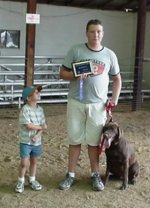
Graduate
Beginner-Graduate Novice
Meredith
Laurence, Lincoln

State
fair delegates
Greg
Harmon ó Junior Dog Showmanship
Adrienne
Hildebrandt ó Dog, Beginner I
Brook
Wibben ó Dog, Beginner I
Seth
Goodman ó Dog, Beginner II
Meredith
Laurence ó Dog, Graduate Beginner
Showmanship
Blue Award winners
Dustin
Aylesworth
Elizabeth
Carter
Caleb
Crawford
Elizabeth
Fanning
Greg
Harmon
Hanna
Laramie
Hannah
Wagner
Brook
Wibben
Brian
Willmert
Dog
Care
Blue Award
Dustin
Aylesworth
|
Beginner
I Class
Blue Award Winners
Elizabeth
Carter
Caleb
Crawford
Elizabeth
Fanning
Greg
Harmon
Emily
Hauter
Adrienne
Hildebrandt
Hanna
Laramie
Samantha
Nichols
Hannah
Wagner
Brook
Wibben
Brian
Willmert
Beginner
II Class
Blue Awards
Dustin
Aylesworth
Seth
Goodman
Graduate
Beginner Class
Blue Award
Meredith
Laurence
|
|
|
Results
of 2001 Logan County 4-H shows
[JULY
20, 2001] Listed
below are the results of Logan County 4-H shows on Tuesday, July 17,
at the Extension Building on the fairgrounds.
|
|
4-H
Food and Nutrition Show
Tricks
for Treats I
Blue
Awards
Courtney
Akers
Kristine
Apel
Jamie
Bobell
Kelli
Brooks
Maxwell
Buse
Jonathon
Davis
Sarah
Deal
Katie
Gosda
Devin
Pegram
Hannah
Sheley
Esther
Tomlinson
Hannah
Wagner
Karolyn
White
Tricks
for Treats II
Blue
Awards
Benjamin
Beavers
Michelle
Boyer
John
Brooks
Kelly
Gosda
Holly
Ingram
Michelle
Johnson
Letís
Start Cooking
Blue
Awards
Nichole
Benz
Emily
Bobell
Maxwell
Buse
Rebekah
Crider
Kelly
Gosda
Greg
Harmon
Emily
Hauter
Zack
Huffer
Jenna
Opperman
Devin
Pegram
Laura
Schahl
Katrina
Schreiner
You
Learn to Bake
Blue
Awards
Jessica
Allen
Lorraine
Allen
Nichole
Benz
Kristin
Bishop
Michelle
Boyer
John
Brooks
Emma
Cross
Jonathon
Davis
Hollie
Dollinger
Jenna
Opperman
Kathryn
Opperman
Katrina
Schreiner
Hannah
Sheley
Katie
Turner
Krista
Ubbenga
Hannah
Wagner
Caiti
Wunderlin
Red
Award
Elizabeth
Fanning
Sports
Nutrition
Blue
Awards
Katelyn
Beavers
Benjamin
Buse
Abby
Coers
Katie
Gosda
Jill
Patrick
Allicent
Pech
Dairy
Foods
Blue
Awards
Emily
Bakken
Jackie
Bakken
Angela
Cunningham
Amanda
Davison
Krista
Ubbenga
Exploring
Food Heritage
Blue
Awards
Benjamin
Buse
Elizabeth
Carter
Kelly
Cross
Megan
Johnson
Jill
Patrick
Krista
Ubbenga
Exploring
Outdoor Eating
Blue
Awards
Timothy
Carter
Foods
with International Flavor
Blue
Awards
Emily
Bakken
Jackie
Bakken
Elizabeth
Brooks
Natalie
Coers
Amanda
Davison
Sarah
Deal
Holly
Ingram
Ashley
Lamb
Abrigail
Sasse
Jennifer
Schahl
Kimberly
Turner
Krista
Ubbenga
Marjorie
White
[to top of second column in
this listing]
|
Breads
and Cereals
Blue
Awards
Emily
Bakken
Jackie
Bakken
Katelyn
Beavers
Abby
Coers
Natalie
Coers
Angela
Cunningham
Amanda
Davison
Mary
Healy
Ruth
Healy
Holly
Ingram
Jessica
Lindgren
Abrigail
Sasse
Krista
Ubbenga
Fruits
and Vegetables
Blue
Awards
Chris
Ackerman
Emily
Bakken
Elizabeth
Brooks
Susan
Cochran
Abby
Coers
Natalie
Coers
Amanda
Davison
Mary
Healy
Holly
Ingram
Jill
Patrick
Abrigail
Sasse
Krista
Ubbenga
Food
Preservation
Blue
Awards
Chris
Ackerman
Elizabeth
Carter
Mary
Healy
Abrigail
Sasse
Krista
Ubbenga
Food
Demonstration
Blue
Award
Jill
Patrick
Cake
Decorating
Blue
Awards
Elizabeth
Carter
Krista
Ubbenga
4-H
Home and Family Show
Design
Decisions/Beginning
Blue
Awards
Bethany
Furman
Sarah
Moore
Jenna
Opperman
Child
Development II
Blue
Awards
Michelle
Johnson
Krista
Ubbenga
Red
Award
Marjorie
White
Child
Development III
Blue
Award
Mary
Healy
Health
II
Red
Award
Camillia
Bone
Sewing
and Textiles I
Blue
Awards
Nichole
Benz
Kristin
Bishop
Bethany
Furman
Rachael
Jones
Kathryn
Opperman
Colleen
Pech
Katrina
Schreiner
Katie
Turner
Hannah
Wagner
Sewing
and Textiles II
Blue
Awards
Katelyn
Beavers
Abby
Coers
Leanna
Gleason
Allicent
Pech
Kimberly
Turner
Marjorie
White
Sewing
and Textiles II
Red
Awards
Elizabeth
Carter
Jennifer
Schahl
Sewing
and Textiles III
Blue
Awards
Emily
Bakken
Leila
Ballinger
Amanda
Davison
Abrigail
Sasse
Krista
Ubbenga
|
|
|